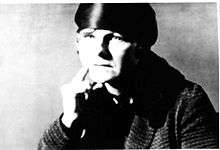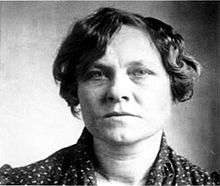Ruth Snyder
| Ruth Brown Snyder | |
|---|---|
 | |
| Born |
Ruth Brown March 27, 1895 |
| Died |
January 12, 1928 (aged 32) Sing Sing Prison, Ossining, New York, U.S. |
| Occupation | Housewife |
| Criminal charge | Murder |
| Criminal status | Executed by electric chair |
| Spouse(s) | Albert Snyder (died 1927) |
| Children | 1 |

Ruth Brown Snyder (March 27, 1895 – January 12, 1928) was an American murderer. Her execution in the electric chair at Sing Sing Prison for the murder of her husband, Albert, was recorded in a well-known photograph.
Crime
In 1925, Snyder, a housewife from Queens Village, Queens, New York City, began an affair with Henry Judd Gray, a married corset salesman. She then began to plan the murder of her husband, enlisting the help of her new lover, though he appeared to be very reluctant. Her distaste for her husband apparently began when he insisted on hanging a picture of his late fiancée, Jessie Guishard, on the wall of their first home, and named his boat after her. Guishard, whom Albert described to Ruth as "the finest woman I have ever met", had been dead for 10 years.[1]
Ruth Snyder first persuaded her husband to purchase insurance, with the assistance of an insurance agent (who was subsequently fired and sent to prison for forgery) "signed" a $48,000 life insurance policy that paid extra ("double indemnity") if an unexpected act of violence killed the victim. According to Henry Judd Gray, Ruth had made at least seven attempts to kill her husband, all of which he survived.[2][3] On March 20, 1927, the couple garrotted Albert Snyder and stuffed his nose full of chloroform-soaked rags, then staged his death as part of a burglary.[3] Detectives at the scene noted that the burglar left little evidence of breaking into the house; moreover, that the behavior of Mrs. Snyder was inconsistent with her story of a terrorized wife witnessing her husband being killed.[2]
Then the police found the property Ruth claimed had been stolen. It was still in the house, but hidden. A breakthrough came when a detective found a paper with the letters "J.G." on it (it was a memento Albert Snyder had kept from former love Jessie Guishard), and asked Ruth about it. A flustered Ruth's mind immediately turned to her lover, whose initials were also "J.G.," and she asked the detective what Gray had to do with this. It was the first time Gray had been mentioned, and the police were instantly suspicious. Gray was found upstate, in Syracuse. He claimed he had been there all night, but eventually it turned out a friend of his had created an alibi, setting up Gray's room at a hotel. Gray proved far more forthcoming than Ruth about his actions. He was caught and returned to Jamaica, Queens and charged along with Ruth Snyder.[2][3] Dorothy Parker told Oscar Levant that Gray tried to escape the police by taking a taxi from Long Island to Manhattan, New York, which Levant noted was "quite a long trip." According to Parker, in order "not to attract attention, he gave the driver a ten-cent tip."[4]
Trial
Snyder was imprisoned at Sing Sing in Ossining, New York, about 30 miles north of New York City. Her prison cell there would in the future also be used to hold Eva Coo and "Lonely Hearts killer" Martha Beck.
The trial at the Long Island City Courthouse was covered by such figures as Peggy Hopkins Joyce, Mary Roberts Rinehart, Aimee Semple McPherson, D. W. Griffith, Damon Runyon, Will Durant, James M. Cain (crime reporter who wrote the novella that became the movie, "Double Indemnity") and, a year before her own death from cancer, Nora Bayes. Runyon disparaged the crime's status as a clever attempt at a murder—he nicknamed it "the dumb-bell murder case" because "it was so dumb!"

Ruth Snyder and Gray turned on each other, contending the other was responsible for killing Albert Snyder; both were convicted and sentenced to death.[5]
Execution
Snyder became the first woman executed in Sing Sing since 1899. She went to the electric chair only moments before her former lover.[2][3] Her execution (by "State Electrician" Robert G. Elliott) was caught on film, by a photograph of her as the electricity was running through her body, with the aid of a miniature plate camera custom-strapped to the ankle of Tom Howard, a Chicago Tribune photographer working in cooperation with the Tribune-owned New York Daily News.[6] Howard's camera was owned for a while by inventor Miller Reese Hutchison,[7] then later became part of the collections of the Smithsonian's National Museum of American History.[6]
Snyder was interred in the Woodlawn Cemetery, Bronx, New York, with a gravestone that simply reads "Brown".[8]
Lorraine Snyder
Albert and Ruth had one child, a daughter named Lorraine, who was nine at the time of her father's murder. Following the pronouncement of the death sentence on her mother (May 1927), legal disputes arose between the relatives of both Albert and Ruth Snyder regarding the care of Lorraine. Warren Schneider, brother of Albert Snyder, petitioned to be allowed to appoint a legal guardian who was not a member of Ruth Snyder's family. Josephine Brown, mother of Ruth Snyder, also petitioned for custody of the girl.[9] Lorraine had been in the care of Mrs. Brown since the murder.[10] Lorraine was formally placed, by her maternal grandmother, in the Catholic institution where she had been residing at the time of her mother's execution. Ruth requested that her daughter not be brought to the prison for a final visit.[11]
On September 7, 1927, Josephine Brown was awarded guardianship of the girl.[11][12] During this time, there were disputes with the insurance company Ruth Snyder had used to insure her husband's life. Although one policy, worth US$30,000, was paid out without contest,[13] they filed suit to void two other policies, worth $45,000 and $5,000, respectively. By May 1928, the insurance company made available $4,000 for the maintenance of Lorraine. In November 1928 a ruling in the case was reached, with a court finding the policies could not be collected as they had been issued fraudulently.[14] At the time of the judgment, the lawyer acting on behalf of Snyder and Brown asked the court to allow them to appeal without a printed record, on the basis that the family was destitute and unable to sell the house due to the notoriety of the case. By May 1930 it was finally ruled on appeal that the two policies were invalid.[15]
During her time on death row, Ruth Snyder wrote a sealed letter to be given to Lorraine "when she is old enough to understand".[16] One year after the sentence was carried out, Lorraine was apparently aware that her parents were both dead, but not of the manner of their death.
Depiction in popular media
- The drama Machinal (1928), by playwright Sophie Treadwell, is based on Snyder's trial.
- The Pre-Code Hollywood films Blessed Event (1932) and Picture Snatcher (1933) make references to Snyder's execution.
- A fictionalized version of her case was the basis of scenes in State's Attorney (1932) with John Barrymore as the prosecutor.
- The case was the inspiration for the novel Double Indemnity (1943) by James M. Cain,[17] which was later adapted for the screen (1944) by Billy Wilder and Raymond Chandler.
- Cain also mentioned that his book The Postman Always Rings Twice (1934) took inspiration from the crime [18]
- In The Thing from Another World (1951), photographer Scotty (Douglas Spencer) informs the United States Air Force crew that he attended the execution of Ruth Snyder and Judd Gray.
- In The Bad Seed, William March based his depiction of Bessie Denker's execution upon that of Ruth Snyder.
- Guns N' Roses' 1991 Use Your Illusion albums feature, as part of their enclosed artwork, a photo of the band posing in front of an oversized reproduction of the Daily News' headline/photograph announcing Ruth Snyder's execution.
- The novel A Wild Surge of Guilty Passion (2011), by Ron Hansen, is based on the murder case.
See also
References
- ↑ Snyder/Gray case details
- 1 2 3 4 Murchie, Guy, Jr. (December 29, 1935). "Snyder Murder". Chicago Tribune. pp. 9–10. Retrieved May 9, 2015.
- 1 2 3 4 "Story of the Crime". Chicago Tribune. January 13, 1928. p. 2. Retrieved May 9, 2015.
- ↑ Levant, Oscar (1965). The Memoirs of an Amnesiac. New York: G. P. Putnam's Sons. p. 90.
- ↑ "Women Faint at Gray's Horror Story". Chicago Tribune. May 5, 1927. pp. 2, 4. Retrieved May 9, 2015.
- 1 2 Tom Howard's Ankle Camera (1928) at the National Museum of American History
- ↑ "Owner of camera that took death cell pictures a recent visitor here". Clipping from The Birmingham News. Birmingham Public Library. February 9, 1938. Retrieved 2010-04-20.
- ↑ Ruth Snyder at Find a Grave
- ↑ Josephine Brown petitions for custody of Lorraine Snyder
- ↑ https://news.google.com/newspapers?id=supPAAAAIBAJ&sjid=3lQDAAAAIBAJ&dq=josephine%20brown&pg=2323%2C5380779
- 1 2 Ruth Brown requests daughter not come for final visit
- ↑ Josephine Brown awarded guardianship of granddaughter Lorraine
- ↑ https://news.google.com/newspapers?id=HssaAAAAIBAJ&sjid=4ksEAAAAIBAJ&dq=josephine%20brown&pg=1978%2C1172947
- ↑ https://news.google.com/newspapers?id=328bAAAAIBAJ&sjid=80oEAAAAIBAJ&dq=lorraine%20snyder&pg=6348%2C352384
- ↑ Appeal ruling by court that insurance policies are invalid
- ↑ https://news.google.com/newspapers?id=kOtXAAAAIBAJ&sjid=60QNAAAAIBAJ&dq=josephine%20brown%20lorraine%20snyder&pg=6876%2C1263081
- ↑ The Executions of Ruth Snyder and Henry Judd Gray from truTV
- ↑ James M. Cain interviewed by David Zinsser in The Art of Fiction No. 69 from The Paris Review
Bibliography
- MacKellar, Landis: The "Double Indemnity" Murder: Ruth Snyder, Judd Gray, & New York's Crime of the Century: (Syracuse, NY: Syracuse University Press, 2006). ISBN 0-8156-0824-1
- Jessie Ramey: The Bloody Blonde and the Marble Woman: Gender and Power in the Case of Ruth Snyder, in: Journal of Social History Vol. 37, No. 3 (Spring, 2004), pp. 625–650
External links
- Mug shot of Ruth Snyder (high-resolution) from Lloyd Sealy Library, John Jay College of Criminal Justice
- Snyder/Gray murder case details, from The People's Almanac by David Wallechinsky & Irving Wallace
- Ruth Snyder at Find a Grave